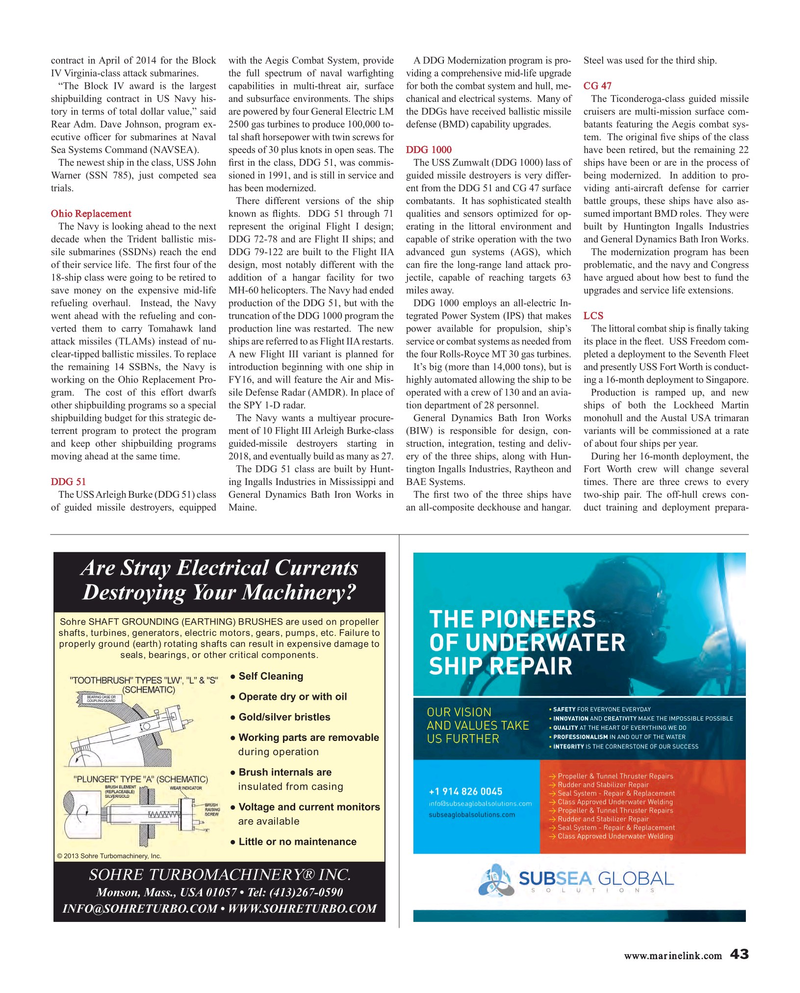
Page 43: of Maritime Reporter Magazine (June 2015)
Annual World Yearbook
Read this page in Pdf, Flash or Html5 edition of June 2015 Maritime Reporter Magazine
contract in April of 2014 for the Block with the Aegis Combat System, provide A DDG Modernization program is pro- Steel was used for the third ship.
IV Virginia-class attack submarines. the full spectrum of naval war? ghting viding a comprehensive mid-life upgrade “The Block IV award is the largest capabilities in multi-threat air, surface for both the combat system and hull, me- CG 47 shipbuilding contract in US Navy his- and subsurface environments. The ships chanical and electrical systems. Many of The Ticonderoga-class guided missile tory in terms of total dollar value,” said are powered by four General Electric LM the DDGs have received ballistic missile cruisers are multi-mission surface com-
Rear Adm. Dave Johnson, program ex- 2500 gas turbines to produce 100,000 to- defense (BMD) capability upgrades. batants featuring the Aegis combat sys- ecutive of? cer for submarines at Naval tal shaft horsepower with twin screws for tem. The original ? ve ships of the class
Sea Systems Command (NAVSEA). speeds of 30 plus knots in open seas. The DDG 1000 have been retired, but the remaining 22
The newest ship in the class, USS John ? rst in the class, DDG 51, was commis- The USS Zumwalt (DDG 1000) lass of ships have been or are in the process of
Warner (SSN 785), just competed sea sioned in 1991, and is still in service and guided missile destroyers is very differ- being modernized. In addition to pro- trials. has been modernized. ent from the DDG 51 and CG 47 surface viding anti-aircraft defense for carrier
There different versions of the ship combatants. It has sophisticated stealth battle groups, these ships have also as-
Ohio Replacement known as ? ights. DDG 51 through 71 qualities and sensors optimized for op- sumed important BMD roles. They were
The Navy is looking ahead to the next represent the original Flight I design; erating in the littoral environment and built by Huntington Ingalls Industries decade when the Trident ballistic mis- DDG 72-78 and are Flight II ships; and capable of strike operation with the two and General Dynamics Bath Iron Works. sile submarines (SSDNs) reach the end DDG 79-122 are built to the Flight IIA advanced gun systems (AGS), which The modernization program has been of their service life. The ? rst four of the design, most notably different with the can ? re the long-range land attack pro- problematic, and the navy and Congress 18-ship class were going to be retired to addition of a hangar facility for two jectile, capable of reaching targets 63 have argued about how best to fund the save money on the expensive mid-life MH-60 helicopters. The Navy had ended miles away. upgrades and service life extensions.
refueling overhaul. Instead, the Navy production of the DDG 51, but with the DDG 1000 employs an all-electric In- went ahead with the refueling and con- truncation of the DDG 1000 program the tegrated Power System (IPS) that makes LCS verted them to carry Tomahawk land production line was restarted. The new power available for propulsion, ship’s The littoral combat ship is ? nally taking attack missiles (TLAMs) instead of nu- ships are referred to as Flight IIA restarts. service or combat systems as needed from its place in the ? eet. USS Freedom com- clear-tipped ballistic missiles. To replace A new Flight III variant is planned for the four Rolls-Royce MT 30 gas turbines. pleted a deployment to the Seventh Fleet the remaining 14 SSBNs, the Navy is introduction beginning with one ship in It’s big (more than 14,000 tons), but is and presently USS Fort Worth is conduct- working on the Ohio Replacement Pro- FY16, and will feature the Air and Mis- highly automated allowing the ship to be ing a 16-month deployment to Singapore. gram. The cost of this effort dwarfs sile Defense Radar (AMDR). In place of operated with a crew of 130 and an avia- Production is ramped up, and new other shipbuilding programs so a special the SPY 1-D radar. tion department of 28 personnel. ships of both the Lockheed Martin shipbuilding budget for this strategic de- The Navy wants a multiyear procure- General Dynamics Bath Iron Works monohull and the Austal USA trimaran terrent program to protect the program ment of 10 Flight III Arleigh Burke-class (BIW) is responsible for design, con- variants will be commissioned at a rate and keep other shipbuilding programs guided-missile destroyers starting in struction, integration, testing and deliv- of about four ships per year. moving ahead at the same time. 2018, and eventually build as many as 27. ery of the three ships, along with Hun- During her 16-month deployment, the
The DDG 51 class are built by Hunt- tington Ingalls Industries, Raytheon and Fort Worth crew will change several
DDG 51 ing Ingalls Industries in Mississippi and BAE Systems. times. There are three crews to every
The USS Arleigh Burke (DDG 51) class General Dynamics Bath Iron Works in The ? rst two of the three ships have two-ship pair. The off-hull crews con- of guided missile destroyers, equipped Maine. an all-composite deckhouse and hangar. duct training and deployment prepara- $UH6WUD\(OHFWULFDO&XUUHQWV 'HVWUR\LQJ Sohre SHAFT GROUNDING (EARTHING) BRUSHES are used on propeller shafts, turbines, generators, electric motors, gears, pumps, etc. Failure to properly ground (earth) rotating shafts can result in expensive damage to seals, bearings, or other critical components. ?6HOI&OHDQLQJ ?2SHUDWHGU\RUZLWKRLO ?*ROGVLOYHUEULVWOHV ?:RUNLQJSDUWVDUHUHPRYDEOH during operation ?%UXVKLQWHUQDOVDUH insulated from casing ?9ROWDJHDQGFXUUHQWPRQLWRUV are available ?/LWWOHRUQRPDLQWHQDQFH © 2013 Sohre Turbomachinery, Inc. SOHRE TURBOMACHINERY® INC. 0RQVRQ0DVV86$?7HO ,1)2#62+5(785%2&20?:::62+5(785%2&20 www.marinelink.com 43 MR #6 (42-49).indd 43 MR #6 (42-49).indd 43 6/9/2015 1:49:57 PM6/9/2015 1:49:57 PM

 42
42

 44
44
